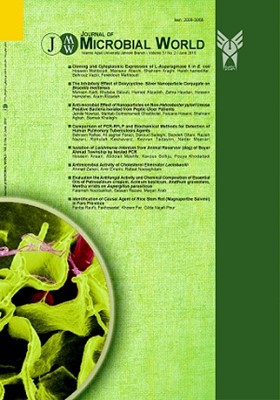اثر مهاری کانجوگه داکسیسیکلین و نانوذرات نقره بر باکتری بروسلا ملیتنسیس
الموضوعات :محسن اجلی 1 , مجتبی صلوتی 2 , حامد علیزاده 3 , زهرا حیدری 4 , حسین حمزهای 5 , آرام علیزاده 6
1 - دانشگاه آزاد اسلامی، واحد زنجان، گروه میکروبیولوژی
2 - دانشگاه آزاد اسلامی، واحد زنجان، مرکز تحقیقات بیولوژی
3 - دانشگاه آزاد اسلامی، واحد زنجان، باشگاه پژوهشگران جوان
4 - دانشگاه آزاد اسلامی، واحد زنجان، گروه میکروبیولوژی
5 - دانشگاه آزاد اسلامی، واحد زنجان، گروه میکروبیولوژی
6 - دانشگاه آزاد اسلامی، واحد زنجان، گروه میکروبیولوژی
الکلمات المفتاحية: بروسلا, نانو ذرات نقره, اثر ضدمیکروبی, داکسیسیکلین,
ملخص المقالة :
سابقه و هدف: بروسلوزیس یک بیماری مشترک بین انسان و حیوان است که توسط جنس بروسلا ایجاد میشود. در مطالعات اخیر فعالیت ضدمیکروبی نانوذرات نقره به اثبات رسیده است. هدف از این پژوهش، بررسی اثرات ضدمیکروبی و اثر همافزایی کونژوگه داکسیسیکلین و نانوذرات نقره بر روی بروسلا ملیتنسیس 16M بود. مواد و روشها: در ابتدا کونژوگه داکسیسیکلین و نانوذرات نقره تهیه شد. سپس با روش انتشار چاهک اثر مهارکنندگی آن بر روی بروسلا ملیتنسیس 16M در محیط مولر هینتون آگار مورد بررسی قرار گرفت. همچنین با استفاده از روش ماکرودیلوشن حداقل غلظت مهار کننده رشد (MIC) و حداقل غلظت کشنده باکتری (MBC) توسط کونژوگه داکسیسیکلین و نانوذره نقره در محیط مولر هینتون براث تعیین گردید. در نهایت در مدل حیوانی نیز اثر کونژوگه سنتز شده مورد مطالعه قرار گرفت. یافتهها: نتایج نشان داد که کونژوگه داکسیسیکلین و نانوذرات نقره اثر ضدمیکروبی روی باکتری بروسلا ملیتنسیس 16M در شرایط آزمایشگاهی دارد. در مدل حیوانی کونژوگه نانوذرات نقره و داکسیسیکلین کاهش زیادی در میزان باکتریهای بروسلا ملی تنسیس طحالی ایجاد کرد. نتیجه گیری: نتایج این مطالعه نشان داد که کونژوگه داکسیسیکلین و نانوذرات نقره اثر همافزایی بر روی هم دارند و میتواند در درمان بروسلوز مورد توجه قرار گیرد.
1. Rad MA. Brucellosis, Zoonosis disease. 1st edition. University of Tehran Publication. Tehran. 2009; 94-101. [In persian].
2. Ohishi K, Zenitani R, Bando T, Goto Y, Uchida K, Maruyama T, Yamamoto S, Miyazaki N, Fujise Y. Pathological and serological evidence of Brucella-infection in baleen whales (Mysticeti) in the western North Pacific. Comp Immunol Microbiol Infect Dis. 2003; 26: 125-136.
3. Covert J, Eskra L, Splitter G. Isolation of Brucella abortus total RNA from B. abortus-infected murine RAW macrophages. J Microbiol Methods. 2005; 60(3): 383-393.
4. Fischer NO, Verma, A, Goodman CM, Simard JM, Rotello VM. Reversible "irreversible" inhibition of chymotrypsin using nanoparticle receptors. J Am Chem. 2003; 125(44): 13387-13391.
5. Collee JG, Miles RS. Tests for identification of bacteria. In: Collee JG, Duguid JP, Fraser AG, Marmion BP. Mackie And Mccartney Practical Medical Microbiology, 13Th Ed. Vol. 2, New York: Churchill Livingstone. 1989; 525-530.
6. Mohsen Nezhad F, Zeigham H, Mota A, Sattari M, Yadegar A . Antibacterial activity of Eucalyptus extracts on methicillin resistance Staphylococcus aureus. Res J Biol Sci. 2009; 4(8): 905-908.
7. Ahmad I, Beg AZ. Antimicrobial and phytochemical studies on 45 Indian medicinal plants against multi-drug resistant human pathogens. J Ethnopharmacol. 2001; 74(2): 113-123.
8. Ersoy Y, Sonmez E, Tevfik MR, But AD. Comparison of three different combination therapies in the treatment of human brucellosis. Trop Doct. 2005; 35(4): 210-212.
9. Trujillano -Martin I, Garcia-Sanchez E, Fresnadillo MJ, Garcia-Sanchez JE, Garcia-Rodriguez JA, Montez-Martinez I. In vitro activities of five new antimicrobial agents againts Brucella melitensis. Int J Antimicrob Agents. 1999; 12(2): 185-186.
10. Naeini A, Khosravi A, Tadjbakhsh H, Ghazanfari T, Yaraee R, Shokri H. Evaluation of the immunostimulatory activity of Ziziphora tenuior extracts. Comp Clin Pathol. 2010; 19(5): 459-463.
11. Alizadeh H, 2011, Study of antimicrobial effects of silver nanoparticles on Brucella abortus 544 and Brucella melitensis 16M in in vitro, cell culture and animal model. Faculty of basic and medical science, Islamic Azad University, Zanjan branch. [In persian].
12. Ayala-Nunez NV, Lara HH, Ixtepan-Turrent L, Rodriguez-Padilla C. Silver nanoparticles toxicity and bacterial effect against methicillin-resistant Staphylococcus aureus. J Nanobiotechnol. 2009; 5: 2-9.
13. Cho KH, Park JE, Osaka T, Park SG. The study of antimicrobial activity and preservation effects of nanosilver ingrediant. Electrochimica Acta. 2005; 51(5): 956-960.
14. Kora AJ, Arunachalam J. Assessment of antibacterial activity of silver nanoparticles on Pseudomonas aeruginosa and its mechanism of action. World J Microbiol Biotechnol. 2011; 27(5): 1209-1216.
15. Yussef M, Fattal E, Alonso MJ, Roblot-Treupel L, Sauzieres J, Tancrede C, Omnes A, Couvreur P, Andremont A. Effectiveness of nanoparticle-bound ampicillin in the treatment of Listeria monocytogenes infection in athymic nude mice. Antimicrob Agents Chemother. 1988; 32(8): 1204-1207.
16. Ayala-Nunez NV, Lara HH, Ixtepan-Turrent L, Rodriguez-Padilla C. Bactericidal effect of silver nanoparticles against multidrug-resistant bacteria. World J Microbiol Biotechnol. 2010; 26: 615-621.
17. Li P, Li J, Wu C, Wu Q, Li J. Synergistic antibacterial effects of β-lactam antibiotic combined with silver nanoparticles. J Nanotechnol. 2005; 16(9): 1912-1917.
18. Shahverdi AR, Fakhimi A, Shahverdi HR, Minaian S. Synthesis and effect of silver nanoparticles on the antibacterial activity of different antibiotics against Staphylococcus aureus and Escherichia coli. Nanomedicine. 2007; 3 (2): 168-171.
19. Seleem MN, Munusamy P, Ranjan A, Alqublan H, Pickrell G, Sriranganathan N. Silica-antibiotic hybrid nanoparticles for targeting intracellular pathogens. Antimicrob Agents Chemother. 2009; 53(10): 4270–4274.


